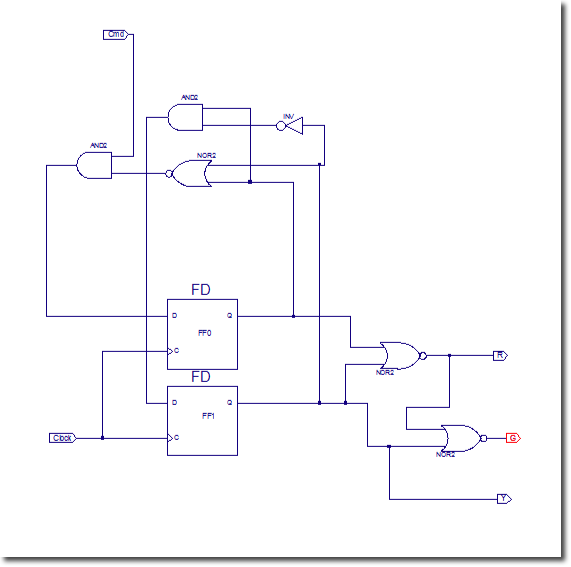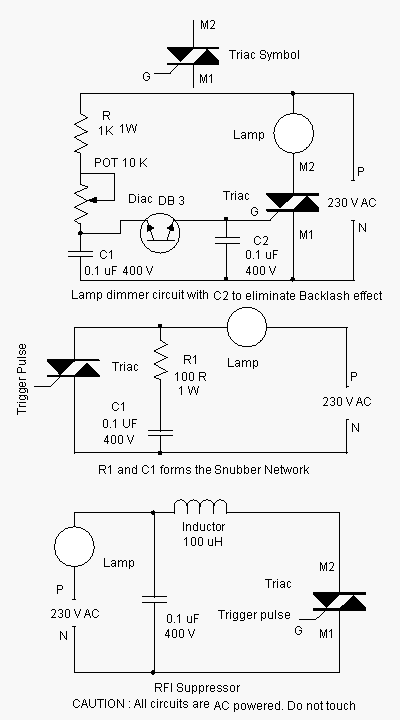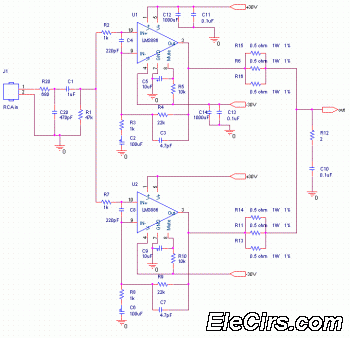
Xilinx ISE Schematics Sequential Circuit

In this lab, flip-flops will be utilized. Xilinx provides a comprehensive library of sequential circuits, which is recommended for circuit searches: Xilinx Reference Library. The objective of this lab is to implement a sequential circuit that controls three LEDs: one green, one yellow, and one red, which stay illuminated for one clock cycle in the following manner: When the external command (cmd) is 0, the cycling halts at the red LED. If cmd is activated while the currently lit LED is not red, the cycling continues through the green-yellow-red sequence and stops at red as long as cmd remains 0. Xilinx supports various flip-flop models, including those with active low signals and negative edge clocks, all of which can be found in the Xilinx Library Manual (available in PDF format). For this lab, the FD flip-flop will be selected. The integrity of wire connections can be verified using cursor mode; by selecting the cursor arrow from the vertical menu and clicking on a wire, all connected wires will turn red. The circuit should be synthesized through the Implement Design menu. Proceed only if synthesis is successful; otherwise, identify issues from the error log in the console window. The design for this three-state sequencer includes a transient state; when Q1 and Q0 are both 1, the system is in State 3, where yellow is 1, and it should automatically transition the FSM to State 0, where red is 1. Verification of correct behavior is not possible unless Q1 and Q0 can be forced to 1. One method to achieve this is by modifying the schematics to incorporate different flip-flop designs with a preset input and adjusting the Verilog test module to activate this preset input at the appropriate times.
The circuit design described involves creating a sequential logic circuit to control three LEDs based on the state of an external command signal. The LEDs will illuminate in a defined sequence, dictated by the states of the flip-flops used in the design. The primary component, an FD flip-flop, will serve as the memory element that retains the state of the circuit.
The sequential circuit will be structured using a finite state machine (FSM) approach, where each state corresponds to a specific LED being lit. The states can be defined as follows: State 0 (Red ON), State 1 (Green ON), State 2 (Yellow ON), and State 3 (both Q1 and Q0 are high, indicating a transient state). The control logic will ensure that when the command signal (cmd) is low (0), the system remains in State 3, lighting the red LED. If cmd is high (1) while the currently lit LED is not red, the FSM will transition through the sequence from green to yellow to red.
In terms of implementation, the circuit will require careful consideration of the timing and edge conditions. The flip-flops must be configured to respond to the clock signal appropriately, with attention to whether they are triggered on a rising or falling edge. The use of a preset input on the flip-flops will allow for manual intervention to force the states of Q1 and Q0 to 1, facilitating the transition to the desired state for testing purposes.
The synthesis process will be critical, as it will compile the Verilog code into a format suitable for the target FPGA. Successful synthesis will confirm that the design is free from errors and ready for further testing and deployment. The console's error log will serve as a valuable resource for diagnosing any issues that arise during this process.
Overall, this lab provides a practical application of sequential circuits, demonstrating the functionality of flip-flops in controlling output devices such as LEDs based on defined input conditions. The design not only emphasizes the importance of state management in digital circuits but also highlights the role of simulation and synthesis in verifying circuit behavior.In this lab we will be using flip-flops. Xilinx offers a large library of sequential circuits. Make sure to check it out when searching for circuits: Xilinx Refernce Library. The circuit we want to implement in this lab is a sequential circuit controlling 3 LEDs, one Green, on Yellow, and one Red that stay on for one cycle of the clock in the fol lowing fashion: When the outside command cmd is 0, the cycling stops on Red. If cmd is activated when the light that is on is not Red, the cycling still follows the Green-Yellow-Red path, and stops on Red as long as cmd remains 0. Xilinx supports many different flip-flop models, some with active low signals, some with negative edge clocks.
You can find them all in the Xilinx Library Manual (in pdf form). We`ll pick the FD flip-flop for this lab: You can verify that a set of wires are connected properly by using cursor mode (you click on the cursor arrow in the vertical menu) and clicking on one of the wires. Every wire connected to that wire, including this wire, will turn red. Synthesize your circuit (in Impement Design menu of options). Continue only if your synthesis is successful. Otherwise figure out what the bugs are from the error log in the console window. Our design for this 3-state sequencer has a transient state. When Q1 and Q0 are 1 1, the system is in State 3, for which Yellow is 1, and it should automatically bring the FSM to State 0, where Red should be 1.
We cannot verify its correct behavior, unless we find a way to force Q1 and Q0 to 1. One way to do this is to modify the schematics and use different flip-flop designs that have a Preset input, and modify the Verilog test module to activate this Preset at the right times. 🔗 External reference
The circuit design described involves creating a sequential logic circuit to control three LEDs based on the state of an external command signal. The LEDs will illuminate in a defined sequence, dictated by the states of the flip-flops used in the design. The primary component, an FD flip-flop, will serve as the memory element that retains the state of the circuit.
The sequential circuit will be structured using a finite state machine (FSM) approach, where each state corresponds to a specific LED being lit. The states can be defined as follows: State 0 (Red ON), State 1 (Green ON), State 2 (Yellow ON), and State 3 (both Q1 and Q0 are high, indicating a transient state). The control logic will ensure that when the command signal (cmd) is low (0), the system remains in State 3, lighting the red LED. If cmd is high (1) while the currently lit LED is not red, the FSM will transition through the sequence from green to yellow to red.
In terms of implementation, the circuit will require careful consideration of the timing and edge conditions. The flip-flops must be configured to respond to the clock signal appropriately, with attention to whether they are triggered on a rising or falling edge. The use of a preset input on the flip-flops will allow for manual intervention to force the states of Q1 and Q0 to 1, facilitating the transition to the desired state for testing purposes.
The synthesis process will be critical, as it will compile the Verilog code into a format suitable for the target FPGA. Successful synthesis will confirm that the design is free from errors and ready for further testing and deployment. The console's error log will serve as a valuable resource for diagnosing any issues that arise during this process.
Overall, this lab provides a practical application of sequential circuits, demonstrating the functionality of flip-flops in controlling output devices such as LEDs based on defined input conditions. The design not only emphasizes the importance of state management in digital circuits but also highlights the role of simulation and synthesis in verifying circuit behavior.In this lab we will be using flip-flops. Xilinx offers a large library of sequential circuits. Make sure to check it out when searching for circuits: Xilinx Refernce Library. The circuit we want to implement in this lab is a sequential circuit controlling 3 LEDs, one Green, on Yellow, and one Red that stay on for one cycle of the clock in the fol lowing fashion: When the outside command cmd is 0, the cycling stops on Red. If cmd is activated when the light that is on is not Red, the cycling still follows the Green-Yellow-Red path, and stops on Red as long as cmd remains 0. Xilinx supports many different flip-flop models, some with active low signals, some with negative edge clocks.
You can find them all in the Xilinx Library Manual (in pdf form). We`ll pick the FD flip-flop for this lab: You can verify that a set of wires are connected properly by using cursor mode (you click on the cursor arrow in the vertical menu) and clicking on one of the wires. Every wire connected to that wire, including this wire, will turn red. Synthesize your circuit (in Impement Design menu of options). Continue only if your synthesis is successful. Otherwise figure out what the bugs are from the error log in the console window. Our design for this 3-state sequencer has a transient state. When Q1 and Q0 are 1 1, the system is in State 3, for which Yellow is 1, and it should automatically bring the FSM to State 0, where Red should be 1.
We cannot verify its correct behavior, unless we find a way to force Q1 and Q0 to 1. One way to do this is to modify the schematics and use different flip-flop designs that have a Preset input, and modify the Verilog test module to activate this Preset at the right times. 🔗 External reference





